
Pisa is a city and comune in Tuscany, central Italy, straddling the Arno just before it empties into the Ligurian Sea. It is the capital city of the Province of Pisa. Although Pisa is known worldwide for its leaning tower, the city of over 91,104 residents contains more than 20 other historic churches, several medieval palaces, and various bridges across the Arno. Much of the city's architecture was financed from its history as one of the Italian maritime republics.
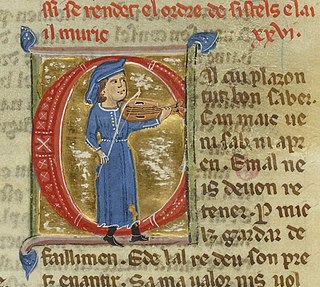
A troubadour was a composer and performer of Old Occitan lyric poetry during the High Middle Ages (1100–1350). Since the word troubadour is etymologically masculine, a female troubadour is usually called a trobairitz.

The Piazza dei Miracoli, formally known as Piazza del Duomo, is a walled 8.87-hectare area located in Pisa, Tuscany, Italy, recognized as an important centre of European medieval art and one of the finest architectural complexes in the world. Considered sacred by the Catholic Church, its owner, the square is dominated by four great religious edifices: the Pisa Cathedral, the Pisa Baptistry, the Campanile, and the Camposanto Monumentale. Partly paved and partly grassed, the Piazza dei Miracoli is also the site of the Ospedale Nuovo di Santo Spirito, which houses the Sinopias Museum and the Cathedral Museum.

Italian literature is written in the Italian language, particularly within Italy. It may also refer to literature written by Italians or in other languages spoken in Italy, often languages that are closely related to modern Italian, including regional varieties and vernacular dialects. Italian literature begins in the 12th century, when in different regions of the peninsula the Italian vernacular started to be used in a literary manner. The Ritmo laurenziano is the first extant document of Italian literature.

Azalais de Porcairagues or Alasais de Porcaragues was a trobairitz, composing in Occitan in the late 12th century.
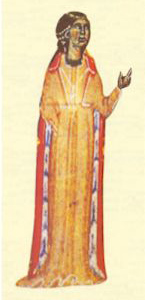
The trobairitz were Occitan female troubadours of the 12th and 13th centuries, active from around 1170 to approximately 1260. Trobairitz is both singular and plural.
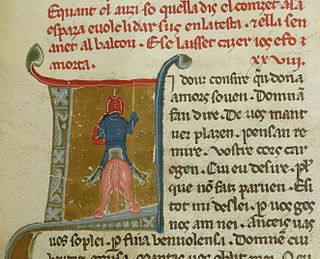
Vida is the usual term for a brief prose biography, written in Old Occitan, of a troubadour or trobairitz.

Pisa Cathedral is a medieval Roman Catholic cathedral dedicated to the Assumption of the Virgin Mary, in the Piazza dei Miracoli in Pisa, Italy, the oldest of the three structures in the plaza followed by the Pisa Baptistry and the Campanile known as the Leaning Tower of Pisa. The cathedral is a notable example of Romanesque architecture, in particular the style known as Pisan Romanesque. Consecrated in 1118, it is the seat of the Archbishop of Pisa. Construction began in 1063 and was completed in 1092. Additional enlargements and a new facade were built in the 12th century and the roof was replaced after damage from a fire in 1595.

The Comtessa de Dia, possibly named Beatritz or Isoarda, was a trobairitz.

Ugolino Visconti, better known as Nino, was the Giudice of Gallura from 1275 or 1276 to his death. He was a son of Giovanni Visconti and grandson of Ugolino della Gherardesca. He was the first husband of Beatrice d'Este, daughter of Obizzo II d'Este. His symbol was a cock.

The history of Corsica in the medieval period begins with the collapse of the Western Roman Empire and the invasions of various Germanic peoples in the fifth century AD, and ends with the complete subjection of the island to the authority of the Bank of San Giorgio in 1511.
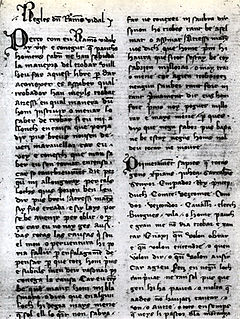
Raimon Vidal de Bezaudu(n) was a Catalan troubadour from Besalù. He is notable for authoring the first tract in a Romance language (Occitan) on the subject of grammar and poetry, the Razós de trobar, a title which translates as "Reasons of troubadour composition". He began his career as a joglar and he spent his formative years at the court of Hug de Mataplana, which he often recalls fondly in his poems and songs.
Paolo Lanfranchi da Pistoia was a noted Italian poet who wrote in both the Italian and Occitan languages. He is thus sometimes described as a troubadour. A native of Pistoia—he was a major cultural figure of the Duecento there—his sonnets have been praised for their originality.

Ferrari da Ferrara, fully Ferrarino (dei) Trogni da Ferrara, was a troubadour of Ferrara in the late 13th and early 14th centuries. He was a composer, anthologist, and possibly autobiographer. He was one of the last active troubadours in Italy.
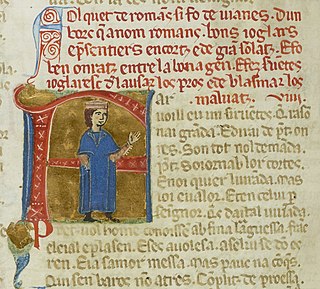
Falquetde Romans was the most famous troubadour attached to the court of Frederick II, Holy Roman Emperor, where he garnered a high reputation despite the fact that his career began as a jongleur. His surviving work consists of fourteen or fifteen pieces: seven sirventes, three tensos, two or three cansos on courtly love, a salut d'amor of 254 lines, and a religious alba. His poetry is, in general, clear and elegant, and he was apparently very religious.
Alais and Yselda were two young noble trobairitz, probably sisters or nuns, who wrote an Occitan tenso with an elderly woman named Carenza. Their poem begins Na Carenza al bel cors avinen, and the first two stanzas were composed by Alais and Yselda. It is the last two stanzas, composed by Carenza, that are the most difficult to interpret. Magda Bogin and Peter Dronke have read the opening line of both her stanzas as beginning with the address N'Alais i na Iselda. There is, however, an alternative interpretation that sees the address as to a "N'Alaisina Iselda". Under this interpretation, there are two, not three, interlocutors in the poem: Carenza and Alaisina Yselda. Within the poem, in favour of the multiplicity of younger women is the phrase nos doas serors, but against it is the continuous use of the first person singular. The poem is preserved amidst a collection of coblas esparsas in only one Italian chansonnier.
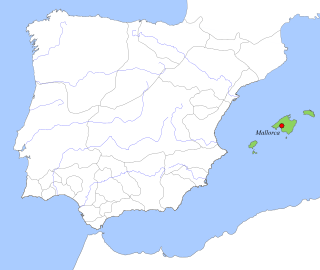
In 1114, an expedition to the Balearic Islands, then a Muslim taifa, was launched in the form of a Crusade. Founded on a treaty of 1113 between the Republic of Pisa and Ramon Berenguer III, Count of Barcelona, the expedition had the support of Pope Paschal II and the participation of many lords of Catalonia and Occitania, as well as contingents from northern and central Italy, Sardinia, and Corsica. The Crusaders were perhaps inspired by the Norwegian king Sigurd I's attack on Formentera in 1108 or 1109 during the Norwegian Crusade. The expedition ended in 1115 in the conquest of the Balearics, but only until the next year. The main source for the event is the Pisan Liber maiolichinus, completed by 1125.

The Battle of Cascina is a never-completed artwork commissioned for creation by Michelangelo for the Palazzo Vecchio in Florence. He created only the preparatory drawing before being called to Rome by Pope Julius II, where he worked on the Pope's tomb; before completing this project, he returned to Florence for some months to complete the cartoon.
The Carmen in victoriam Pisanorum is a poem celebrating the victory of the Italian maritime republics in the Mahdia campaign of 1087. It was probably written by a Pisan cleric within months of the campaign. G. H. Pertz was the first to note the historical value of the text in 1839. It is an important source for the development of Christian ideas about holy war on the eve of the First Crusade (1095–99), and may have been influenced by the contemporary theology of Anselm of Lucca and his circle. It seems to have influenced the Gesta Francorum, an account of the First Crusade composed by someone in the south Italian contingent. All of the later Pisan sources for the Mahdia campaign rely mainly on it: the Chronicon Pisanum only adds details about the memorial church, the Annales Pisani of Bernardo Maragone only rewords the former, and the Cronaca di Pisa of Ranieri Sardo and the Breviarium Pisanae historiae add only legendary material to the account.

Gaia da Camino was an Italian noblewoman and poet hailing from Treviso, Italy. Her family was descended from the Lombards. She is mentioned briefly in Dante Alighieri's Divine Comedy.